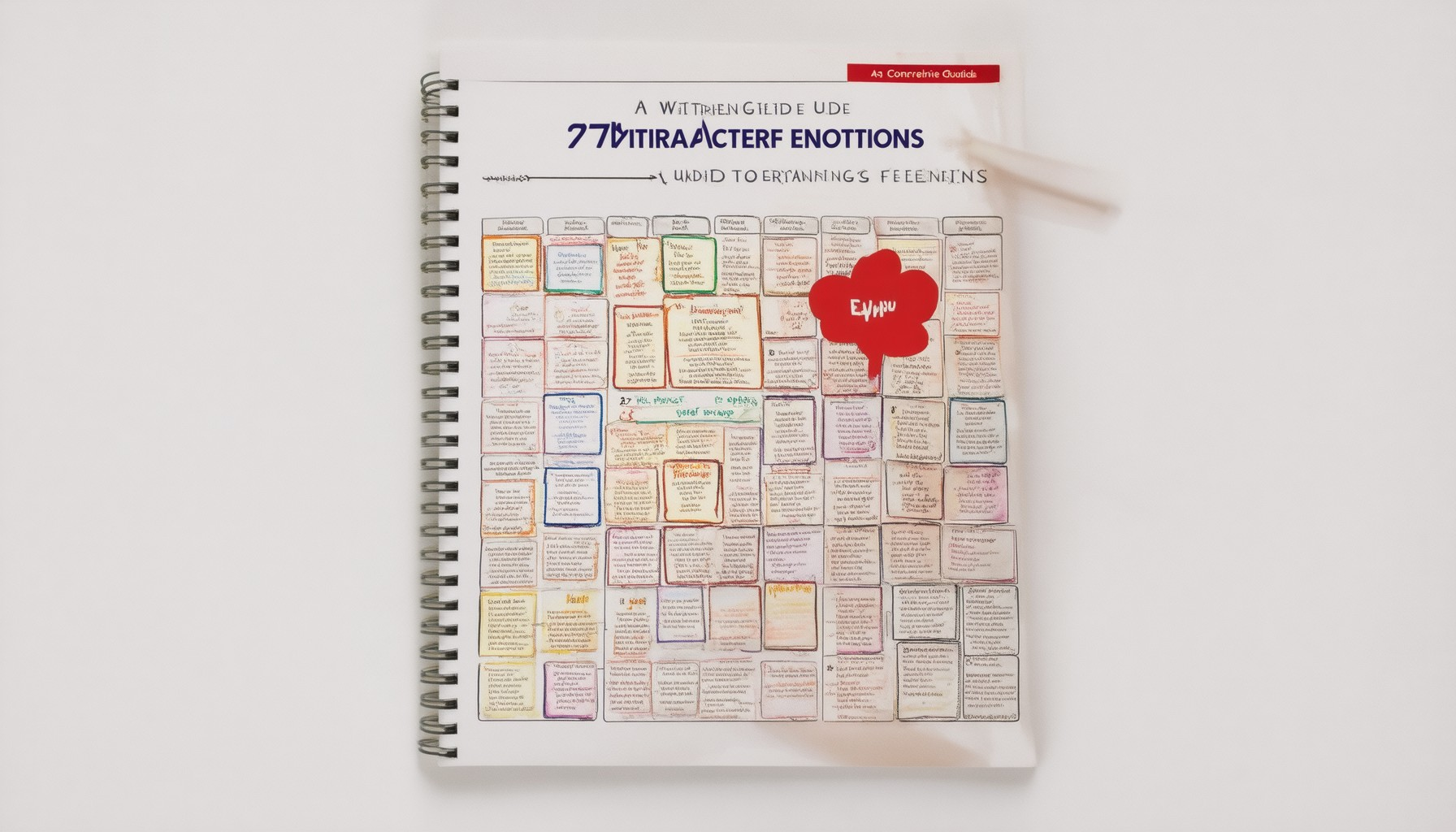Writing character emotions is a cornerstone of great storytelling, requiring authors to navigate the intricate dance between emotion and narrative. Understanding how to convey complex feelings accurately is essential for creating relatable and compelling characters. Whether crafting a hero with unyielding resolve or a villain with icy indifference, mastering the art of emotional expression elevates your writing to new heights. This comprehensive guide delves into the 27 distinct emotions that define human experience, offering insights into how to describe them through body language, dialogue, and introspective thoughts. From subtle cues to overt displays, we’ll explore strategies for balancing emotional expression with authenticity, ensuring your characters resonate deeply with readers. By examining how emotions manifest in behavior, dialogue, and internal monologues, this article serves as a valuable resource for writers seeking to refine their craft and create emotionally rich narratives.
Key Takeaways: Writing an Emotionless Character
- Core Traits: Begin by establishing your character’s defining traits, such as logical thinking or self-control. These traits form the foundation of their emotionless demeanor, as seen in characters like Sherlock Holmes who prioritize reason over emotion.
- Interactions: Create calculated conversations where your character engages purposefully without emotional undertones. Balance this with subtle expressions that hint at underlying feelings, adding depth to their character.
- Setting: Place your character in controlled environments that reinforce their stoicism, such as military bases or high-powered corporations. The overall story tone, whether dark or intense, further influences their perceived emotionlessness.
- Conflict Handling: Address both internal and external conflicts. Internally, they may struggle with connecting emotionally, while externally, they face challenges that test their composure, showcasing their resilience.
- Audience Consideration: Tailor your character’s portrayal to suit your audience. Younger readers might find them less relatable, whereas older audiences may appreciate their complexity in thrillers or dramas.
By focusing on these elements, you can craft a compelling, multi-dimensional emotionless character that captivates readers.

The 27 Distinct Emotions
- Anger
- Fear
- Happiness
- Sadness
- Surprise
- Disgust
- Neutral
- Interest
- Contempt
- Cheerfulness
- Confusion
- Concentration
- Determination
- Distress
- Enthusiasm
- Excitement
- Fascination
- Friendliness
- Guilt
- Hope
- Joy
- Love
- Melancholy
- Nostalgia
- Pride
- Rage
- Relief
- Remorse
- Resentment
- Sadness
- Self-pity
- Shame
- Startle
- Stress
- Surprise
- Terror
- Wonder
- Zest
How to Describe a Character’s Feelings
To effectively describe a character’s feelings in writing, consider the following approaches:
1. Body Language
- Use physical cues to indicate emotion. For example, “She clenched her fists, her knuckles whitening with anger.”
2. Facial Expressions
- Capture subtle changes in the face. Examples include, “His brow furrowed deeply in concentration,” or “A small smile tugged at the corner of his lips.”
3. Dialogue
- Let words reveal inner thoughts. You might write, “He hesitated, his voice trembling slightly as he said, ‘I’m not sure about this.'”
4. Actions
- Show behavior that reflects emotions. For instance, “She avoided eye contact, shifting her gaze nervously around the room.”
5. Internal Thoughts
- Depict mental states through introspection. One might write, “He wondered if he had made the right decision, feeling a pang of doubt.”
Tips for Effective Descriptions:
-
- Focus on showing, not telling. Use descriptive actions rather than stating emotions directly.

Emotional Reactions Explained
Here is a comprehensive list of 15 emotional reactions, categorized for better understanding:
- Basic Emotions:
- Happiness
- Sadness
- Anger
- Fear
- Surprise
- Disgust
- Curiosity
- Excitement
- Love
- Guilt
- Shame
- Pride
- Jeanie
- Envy
- Greed
- Complex Emotions:
- Jealousy vs. Envy: Jealousy stems from fear of loss, while envy is desire for another’s possessions.
- Awe: Admiration toward something extraordinary.
- Pity: Feeling sorry for someone’s misfortune.
- Compassion: Deep care for others’ well-being.
- Regret: Wishing past actions could be changed.
- Guilt: Remorse over personal actions.
- Shame: Embarrassment due to personal failings.
- Embarrassment: Awkwardness or discomfort in social situations.
- Admiration: Respect for someone’s achievements.
- Gratitude: Appreciation for life’s blessings.
- Wonder: Curiosity or amazement about something.

How to Write a Good Emotionless Character
Creating an emotionless character can be a fascinating challenge in storytelling. These characters often stand out due to their unique traits and ability to remain composed under various circumstances. Here’s a guide to crafting a compelling emotionless character:
1. Define the Core Trait
- Logical Thinking : Characters like Sherlock Holmes are defined by their logical approach to problem-solving. Their emotionless demeanor stems from their focus on reason and deduction.
- Self-Control : Another trait that defines emotionless characters is their ability to suppress their emotions. This can make them appear calm and collected regardless of the situation.
2. Interactions with Others
- Calculated Conversations : Emotionless characters tend to engage in conversations that are purposeful and free from emotional undertones. They may appear detached, which can make them intriguing to readers.
- Subtle Expressions : While they may not show obvious emotions, subtle flickers or micro-expressions can hint at their true feelings, adding depth to their character.
3. Setting and Environment
- Controlled Environments : Placing your emotionless character in settings like military bases or high-powered corporations can reinforce their stoic nature, as these environments value logic and efficiency.
- Tone of the Story : The overall tone of the story, whether dark and suspenseful or intense and dramatic, will influence how emotionless a character appears.
4. Handling Conflict
- Internal Conflict : An emotionless character may struggle with forming connections, leading to internal battles between their nature and desire to relate to others.
- External Challenges : External conflicts, such as battles or high-stakes situations, can test their emotionless state, showcasing their resilience and composure.
5. Audience Consideration
- Target Audience : The portrayal of an emotionless character can vary based on the intended audience. Younger readers might find such characters less relatable, whereas older audiences might appreciate their complexity in thrillers or dramas.
By focusing on these elements, you can create a well-rounded and captivating emotionless character that stands out in your story.
How to Write a Cold-Hearted Character
To create a compelling cold-hearted character, focus on their personality traits, behaviors, and motivations. Here’s a step-by-step guide:
- Define Core Traits: – Emotional detachment: The character struggles to connect emotionally with others, appearing distant or unfeeling. – Ruthlessness: Makes tough decisions without considering the consequences, often prioritizing success over relationships. – Lack of empathy: Inability to understand or share others’ feelings, leading to detached interactions. – Selfishness: Prioritizes personal gain or comfort over others’ needs, sometimes manipulating situations to their advantage.
- Develop Motivations: – Power: The desire to control or dominate others. – Control: A need to manage situations to their advantage, regardless of others’ feelings. – Revenge: A history of past wrongs driving their behavior. – Fear: A deep-seated fear of vulnerability or emotional exposure.
- Create a Backstory: – Explore their upbringing: Were they taught to suppress emotions or view others as tools? – Consider their past relationships: Have they been hurt before, leading to a guarded approach to connections? – Reflect on their current situation: What drives their actions in the present moment?
- Design Supporting Characters: – Create characters who reflect their traits: Friends who mirror their coldness or enemies who challenge it. – Develop characters who oppose their mindset: Those who believe in love or kindness, contrasting their beliefs.
- Craft Dialogue and Actions: – Use clipped speech and monotone to convey emotional detachment. – Show ruthlessness in decision-making: Quick, logical choices without hesitation. – Demonstrate lack of empathy: Dismissing others’ concerns or feelings as unimportant. – Highlight selfishness: Self-centered actions that benefit them personally.
- Set the Scene: – Choose environments that reflect their internal state: Cold, impersonal settings that mirror their emotional distance. – Contrasting settings: Warm, inviting spaces that emphasize their inability to connect.
- Approach Conflict Resolution: – Solve problems with logic and efficiency, ignoring emotional factors. – Show a lack of remorse for tough decisions, focusing solely on outcomes.
- Leave Room for Growth: – Allow moments of vulnerability or humanity to add depth. – Provide opportunities for change or redemption, making them multi-dimensional.
By focusing on these elements, you can create a complex, believable, and relatable cold-hearted character that captivates readers.

How to Write an Emotionally Manipulative Character
To create an emotionally manipulative character, focus on their ability to influence others’ feelings strategically. Here’s a structured approach:
- Understand Human Behavior:** Manipulative characters study emotions deeply, learning to predict and exploit others’ reactions. They observe body language, tone, and subtle cues to gauge emotional states.
- Mirror Emotions:** Reflecting others’ emotions can create empathy, making them more likely to trust the manipulator. Subtly mimic facial expressions or voice inflections to align with the target’s emotional state.
- Use Strategic Silence:** Wait for the perfect moment to respond, allowing their words to carry more weight. Silence can amplify their impact and keep others focused on their emotional state.
- Exploit the Setting:** Choose environments that evoke specific emotions, such as dim lighting or soft music, which can heighten susceptibility to emotional manipulation.
- Target Vulnerabilities:** Identify and target individuals’ insecurities or fears. Address these directly to build trust and control over their emotional responses.
- Employ Subtle Deceptions:** Use “little white lies” or carefully crafted statements that plant doubts or insecurities without being overtly detected.
- Practice Patience:** Emotional manipulation often requires building trust over time. Allow relationships to develop before exerting influence to maintain credibility.
By combining these tactics, a character can manipulate emotions effectively, creating a dynamic and compelling narrative.





0 Comments